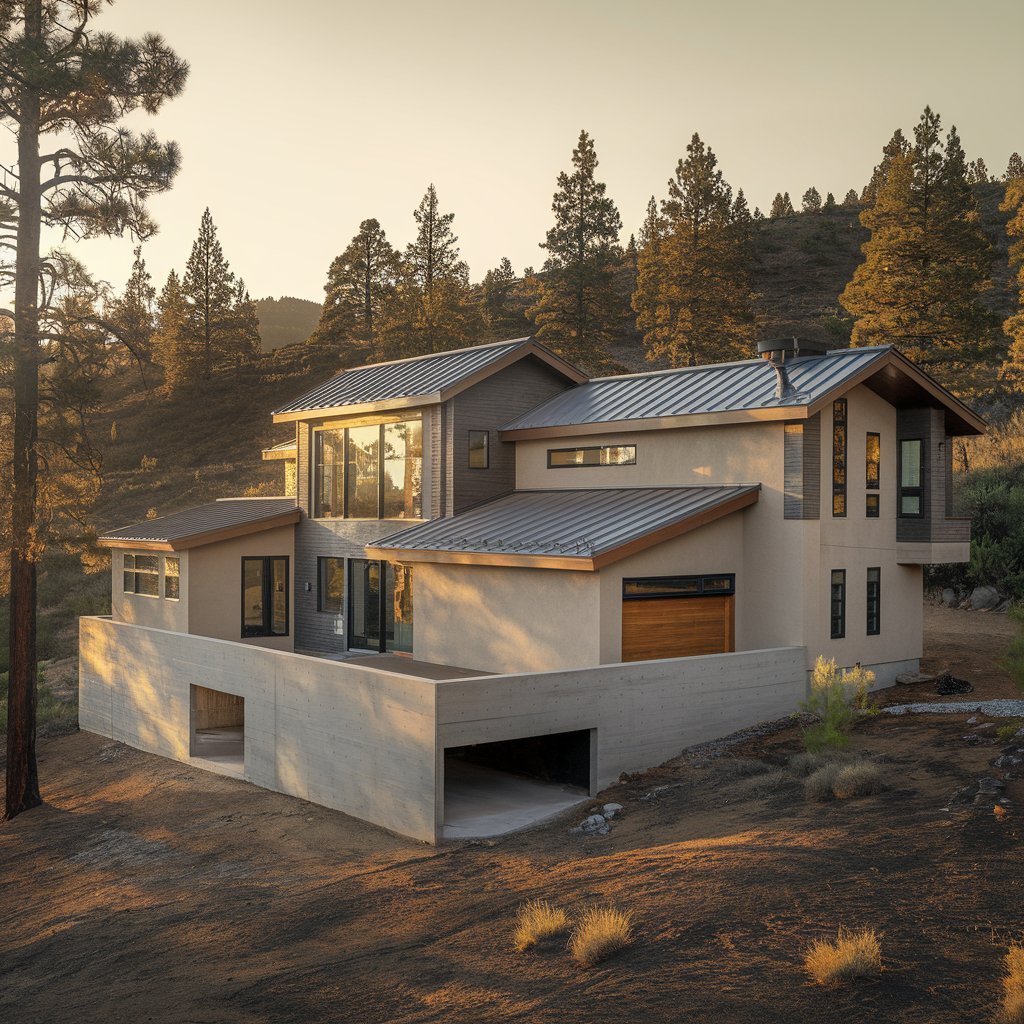Best Fireproof Building Materials for Custom Homes & ADUs
Introduction:
Wildfire dangers have become an increasingly pressing issue for those residing in remote mountain and rural areas. In Colorado alone, the Marshall Fire reduced over 1,000 homes to ashes. These disasters underscore the need for fire-resistant house construction in locations where wildfires frequently occur. Most homes catch fire as a result of windblown embers rather than direct flames. Even if flames don't reach your property, windborne embers still can. This realization has motivated homeowners to opt for building materials and methods that offer resistance to wildfires.
To anyone designing a custom home or ADU in a wildfire-prone area, incorporating fireproof building materials into their construction plans is vital. This post evaluates the most effective fireproof building materials including concrete, stucco, fiber cement, steel, and insulation, in addition to resistant construction methods. We will compare the defensive capabilities of concrete and stucco regarding fires and examine the eco-friendliness and visual appeal of the materials. The vision is to help you construct an elegant home home architectural design that endures wildfires to protect your loved ones
The Science Behind Fireproof Materials
Fire-resistant materials do not ignite or withstand intense heat for an extended amount of time e.g. metal, brick, stone, and even concrete. Non-combustible stucco and fiber cement also slow the rate of fire spread. Gypsum drywall is fire resistant as well, due to containing chemically bound water which releases steam when heated and absorbs energy.
These truths have now been incorporated into building codes. Boulder County requires new homes to be built using ignition-resistant materials. Structures that have no weak spots or fuel sources to burn will be easily bypassed by flames.
Best Fireproof Building Materials
Different materials can have different levels of fire resistance. Below are the best options for custom homes and ADUs:
Concrete: Concrete is one of the most fireproof materials. It can withstand extreme heat without igniting and can act as a fire barrier. Tests show reinforced concrete withstands 1000°C (1832°F) for about an hour before failure in strength, as noted in this source. A well-designed concrete structure will prevent burning and fire spread internally.
Stucco: This cement-based plaster shields homes from fire. A three-coat stucco application (~7/8 inch thick) results in a 1-hour fire rating which means it resists flames for longer than wood siding does. This stucco is one of the best options for homes and buildings located in areas prone to wildfires.
Fiber Cement Siding: The fiber cement siding is made of cement, sand, and cellulose fibers. It has a Class A fire rating as well as not being able to ignite with direct flames. Also, it gives a faux wood appearance and will not combust or deteriorate over time.
Steel & Metal Components: Steel products are non combustible and protect as well. A Steel roof is perfect for these areas as it holds class A fire resistance. Metal siding and soffits also protects homes from embers, proving line-of-sight ignition protection.
Fire-Resistant Insulation: Fire-stopping works differently with mineral wool. It withstands over 1000°C and cannot burn. Between fiberglass which melts, and foam which combusts, mineral wool enhances fire safety inside walls and attics.
Ember-Resistant Construction Techniques
In addition to using fireproof materials, applying ember resistant construction techniques fortifies your home:
Class A Roofing: To begin with, your roof is your first line of defense. Use Class A metal roofs or clay and concrete tiles. Boulder has banned wood shakes, so avoid them.
Fire-Safe Siding & Decks: Use Fiber Cement, stucco or metal siding. Do not use untreated wood or melts like vinyl. Also, enclose deck undersides to stop embers from getting lodged below.
Windows & Doors: Compared to regular glass, tempered glass resists breakage and can withstand higher levels of heat. Use metal or solid core wood doors for fire rated security.
Ember-Proof Vents & Eaves: Install firesafe concrete or other rated materials around eaves to block embers from the attic and soffit vents. Use fire rated metals to cover soffit and attic vents.
These elements work together to prevent wildfire destruction.
Concrete vs. Stucco for Fire Protection
Both concrete and stucco are fire resistant, but differ in their application and effectiveness.
Concrete Walls: Fully fireproof and won't ignite. Offers superior protection but is more expensive and requires skilled labor.
Stucco: Provides a fire resistant coating over a framed wall, delaying ignition. More affordable than concrete but adaptable for existing homes.
Adopting a hybrid approach maximizes fire protection and cost: concrete lower walls, with upper walls of stucco.
Sustainability & Aesthetics
Even though homes might be more appealing than bunkers, fire-resilient homes are no exception. These materials are seamlessly incorporated in modern home design:
Steel and concrete fit contemporary mountain modern styles.
Stucco and fiber cement siding replicate traditional wood aesthetics while being fire-resistant.
Sustainable options like recycled steel and hempcrete add fire safety with eco-friendly benefits.
A well-built wildfire resistant home serves multiple purposes- it is an investment in safety, sustainability, construction, and durability. Moreover, using fireproof materials extends the lifespan of the home while reducing maintenance costs and replacements.
Conclusion & Call to Action
The construction of fire-resistant homes has become a necessity due to the increasing frequency and intensity of wildfires. Homes built with non-flammable materials like stucco, concrete, steel, and fiber cement along with ember-resistant design pose a At ROAM design studio, we specialize in high-end home architectural design and custom house design studio for geographically sensitive areas. Whether it is an ADU or a mountain retreat, we will assist you in building a stunning, sustainable, and fireproof home.
Design a fire-resistant house today! Don’t let wildfire risks take your home—the sanctuary you always wanted. Reach out to ROAM design studio today!


